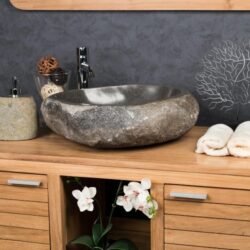Teak Wood should be kiln dried for about three weeks to a moisture content of about 8% before used in manufacturing of teak outdoor furniture.
The drying process increases the stability and hardness of the wood.
If Teak Wood is not properly dried (internal areas have a higher moisture content) then the furniture is subject to splitting and warping if used in an area of low atmospheric humidity
As wood dries, it shrinks. If the outer layers of the wood are dry, but the inner layers are not when the furniture is manufactured, then as the inner layers adapt to the atmospheric moisture content (sometimes a period as short as 6 – 10 days) the wood warps or splits to accommodate the shrinkage.
If the teak wood was properly kiln dried, then the outer and inner moisture content is the same, and the furniture will be stable.
Characteristics of Teak Wood
Teak is an extremely dense [40lbs cuft when dry] fine grained hardwood. Teak wood is generally straight grained, but occasionally wavy. The wood contains a high level of silica which causes rapid blunting of cutting edges.
When fresh cut the surface of the wood is dull in appearance, and the timber has a distinctive, pleasantly aromatic odor which has been likened to the smell of leather. Fresh sawn teak has a slightly ‘oily’ feel due to the high oil content.
One of the most commonly quoted facts about the characteristics of teak is its durability. It is resistant to rot caused by fungal decay, and the high level of resinous oil present in the timber helps to act as a natural insect repellent giving the timber very high resistance to attack by termites and other wood boring insects.
The timber is resistant to water and many chemical reagents, including acids. It does not have a strong reaction when it comes in contact with metals.
The life time in the open for untreated wood (no varnish, lacquer, paint or polishing) is 30 – 35 years.
Bleached Teak Wood
Once Teak Wood is bleached by the elements, its original color can still be restored either by chemical application or by a light sanding.
Teak Cleaners are available from several sources (including ART CLASSIC INDONESIA). These cleaners are caustic, and restore the color by removing a fine layer of the wood and raising the grain slightly. If you use such a teak cleaner, please be sure to rinse the furniture thoroughly, until the residue stops foaming. This may take several rinses. After the rinsing, let the furniture dry thoroughly, and then apply the teak oil finish.
A Light Sanding of the bleached wood will remove the top bleached layer, and also restore the original color. Once again, you will need to apply the teak oil shortly after the sanding process to prevent further bleaching.



